Tuscany is famous for its wines; Chianti, Brunello, Super Tuscan. But Tuscany's quiet next-door neighbour Umbria has some fantastic wines too. These wines are just becoming popular in North America, even though the Etruscans have been making wine here for millennia. Umbria is much more Mountainous with the Apennine range running through the East of this Region creating a colder climate for grape growing. This makes a huge difference in the varieties grown and the flavours they produce. Let's explore some of the local vino!
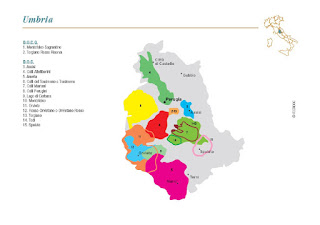 |
| Umbria DOC/DOCG Wine Treasure Map |
Umbria has thirteen DOC regions and 2 DOCG regions. These acronyms are both wine quality control labels that control the production area, the varieties of grapes used in the wine, the wine colour, alcohol levels and how the wines are matured. DOC is Denomination of Controlled Origin, and Italy has 334 in 2018, with another 408 "protected" wine areas that may become DOC one day.
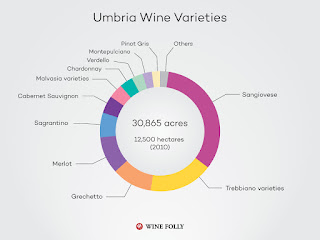 |
| Graph From Wine Folly Blog |
DOCG is a GUARANTEED Controlled Origin; meaning this wine is Italy's top product. There are 2 DOCG wines in Umbria: Montefalco Sagrantino and Torgiano Rosso Riserva. I was amazed that Umbria's famous white wine from Orvietto was NOT on the DOCG list! The two main white varieties grown in Umbria are Trebbiano and Grechetto. The main red varieties grown are Sangiovese, Torgiano and Sagrantino. The last two of these are getting A LOT of attention lately and are both DOCG wines. Let's start with those.
1. Sagrantino di Montefalco ~
This wine is HOT right now all over the world. Sagrantino wine is made from the mysterious grape variety of the same name. The DOCG region it belongs to is the area around the pretty little hilltown of Montefalco. This wine is like Tuscany's Brunello di Montalcino, and there is a whole wine tourism industry built around the wineries of Montefalco. This includes the "Strada del Sagrantino" a driving route that takes you to different wineries and towns that produce Montefalco Sagrantino. Sagrantino wine is made from 100% Sagrantino grapes that are aged for a minimum of 37 months; 12 of those months must be in oak barrels. This is an intense, full-bodied wine that is off the hook for tannins and tastes like berry.spice.raisin.smoke. Sagrantino also ages like a dream. To find out more about this really unique wine check out THIS post.
2. Torgiano Rosso Reserva and Rubesco~
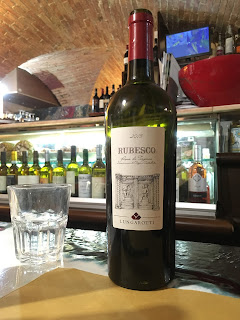
These are actually two separate wines that come from a small town of the same name: Torgiano. Torgiano is a small hamlet a few kilometres from the delightful hill town of Deruta. Torgiano makes red wines: Rosso di Torgiano called Rubesco and the famous Rosso di Torgiano Reserva which is a DOCG wine. The Torgiano Rubesco is aged for 1 year where the Rosso Reserva is aged for 3 years with a minimum of 6 months in the bottle. The primary player in Torgiano is the Lungarotti family winery, and this local family put Torgiano wine on the map. It's a great blend of half Sangiovese, 15-30% Canaiolo grapes, 10% Trebbiano and the rest is Montepulciano and Ciliegiolo. You may know the Canaiolo grape from some famous blends like Chianti and Vino Nobile di Montepulciano. In fact, the Canaiolo grape was the primary grape in Chianti until a blight hit Europe in the 1850s and wiped out much of the Canaiolo vines in Tuscany. Oh, the horror-stupid aphids!
3. Rosso di Montefalco~
This is another wine featuring the Sagrantino grape. The Rosso di Montefalco is also a DOC wine blending 60-70% Sangiovese, 10-15% Sagrantino and the rest a blend of Merlot or Cabernet Sauvignon. It's aged for 18 months, but you can also get a "Rosso di Montefalco Reserva" which is aged for 30 months, 12 of those months in wood barrels. This wine is WAY more mellow than the Sagrantino di Montefalco, but it is still a big, bold red that ages well for up to 10 years after bottling. TIP: You may consider trying this Umbrian red before moving on to the Sagrantino which can be a bit too intense for many people.
4. Sagrantino di Montefalco Passito~

5. Orvieto Classico~
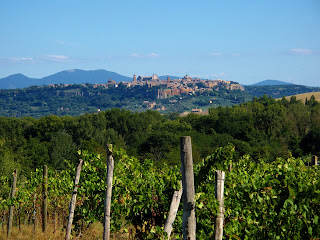 |
| The Grand Hilltown Of Orvieto |
This is probably Umbria's most famous white wine and it is exported all around the world. Heck, I can even get it at my little grocery store here in rural SW Ontario! Named after the famous Umbrian hilltown Orvieto, which was the Popes refuge if Rome were ever under attack. Orvieto Classico is a blend of 40% Grechetto, 20-40% Trebbiano (which is locally called Procanico) and up to 40% other white grape blends such as Verdello and Malvasia Bianco. Orvieto Classico is a DOC wine that is generally a floral yet crisp, light straw-coloured wine. Some producers in the region are now producing a very dry Orvieto "secco" which is gaining in popularity. Try a bunch of different labels to find the one you like most!
6. Orvietto Abboccato~
 |
| Delicious and light Abboccato |
This is another type of wine from Orvietto that used to be exported in the past but has fallen out of favour because it is quite a sweet wine, although not a dessert wine. Abboccato in loose terms means "good in the mouth," and I would thoroughly agree. I had this wine a few times with my lunch, as a restaurant's house white wine and it is light and peachy and well rounded. It paired well with salty/sweet menu items like prosciutto and melon or Panzanella which is a bread and tomato salad. It is an excellent hot weather wine to sip on a patio.
7. Bianco di Todi~
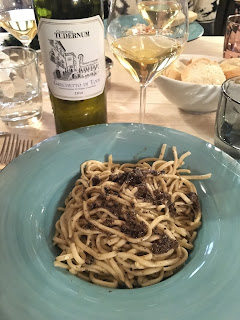
The Medieval hill town of Todi is a new player in the Umbrian DOC scene. Todi was designated as DOC region in 2010, although winemaking here goes back to the (pre-Roman) Etruscan times. Todi is a hill town near Orvieto that grows Grechetto Bianco grapes. This is the same grape that is blended with Trebbiano grapes to make Orvieto Classico wine. Grechetto vines come from Greece, and like the Sagrantino red grape, it is a late harvest grape. Like the Sagrantino grape, the Grechetto is a low yielding grape variety with high sugar content and thick skins that resist the mildew that can happen in late harvest grapes.
There are actually 3 related wines here: 1) Bianco di Todi must be 50% Grechetto grapes 2) the Grechetto di Todi must be minimum 85% Grechetto grapes, and 3) Grechetto Superiore it must be 100% Grechetto and aged for a minimum of 5 months. We tried the Grechetto di Todi with our handmade pasta, and it paired perfectly. Grechetto is light and has a nutty taste and maybe something herbal in the afterglow on the tongue. The Grechetto grape is also used in making Vin Santo a very traditional sweet dessert wine. Todi is becoming known for its Rosso di Todi, a local red wine that is gathering a lot of attention lately-it's on my list to try out next time we are in Umbria.
 |
I WANT IT ALL!!!! |

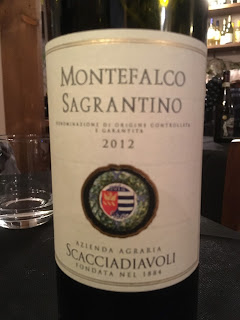


2 comments:
It was a very good post indeed. I thoroughly enjoyed reading it in my lunch time. Will surely come and visit this blog more often. Thanks for sharing. https://wevino.store/
Thank you so much, I am glad you enjoyed it! I have a few other posts on wine in Italy, you can search under the tag "Wine" to see the posts. Salute!
Post a Comment